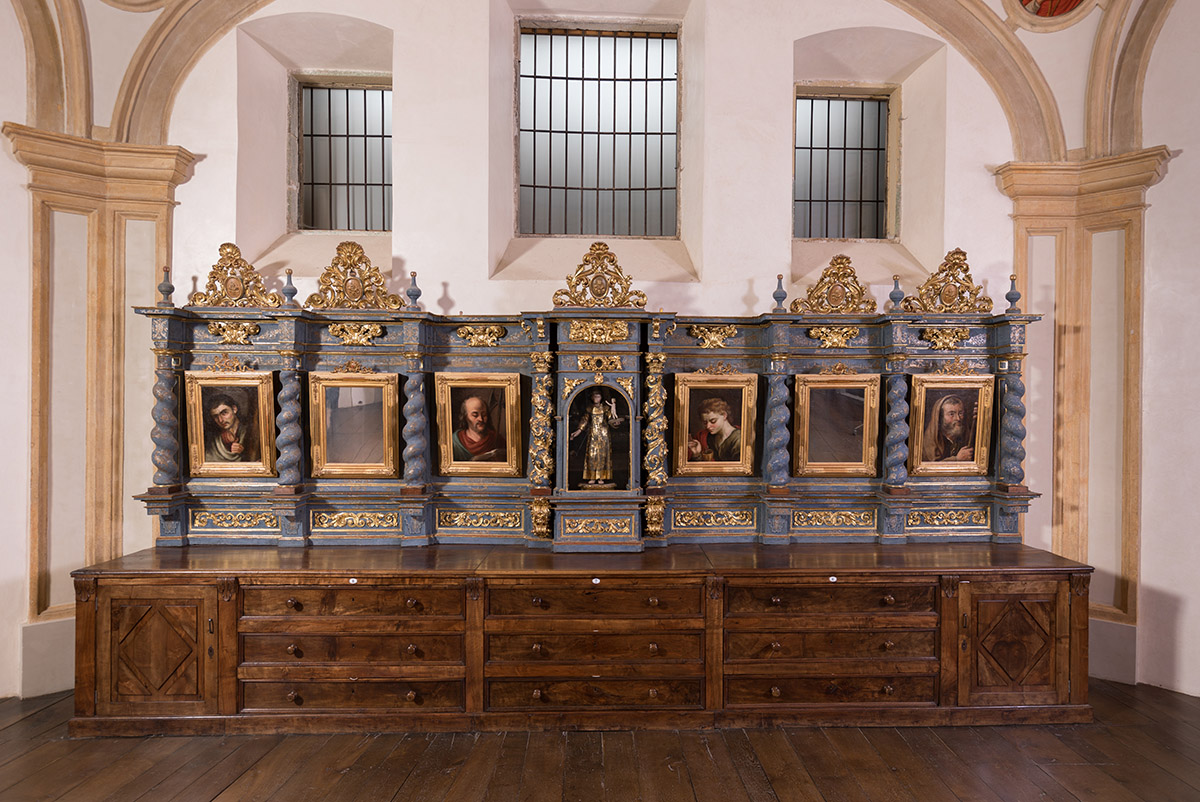Chest of drawers with backboard in the sacristy
Chest of drawers with backboard in the sacristy
The construction of the new sacristy and chapter house was completed between 1734 and 1736. The architect in charge of the design and conditions of the sacristy was Juan Bautista de Arbaiza. There are various reasons why this work was undertaken: on the one hand, it was intended to enhance the collegiate church, although it is also true that behind this major work lay the intention of achieving cathedral status, a dignity that had been longed for since the 16th century. The entire movable component had to be built once the architectural section had been completed. Miguel Olalde, a carpenter from Vitoria, was commissioned to make the chest of drawers. The conditions were drawn up and signed on 5 December 1734. This piece of furniture has unfortunately not survived, as the Alava Provincial Council financed a new chest of drawers for the sacristy in 1864 to the tune of 2,500 reales. The person who created it is unknown, but it was probably made by the brothers Nemesio and Ángel Iturralde, who were very much involved in all the carpentry work carried out at that time in the cathedral. Today’s chest of drawers is made up of four sections of drawers, two for the larger sides of the sacristy and another two for the smaller ones. The larger ones have nine drawers and two cupboards, and the smaller ones have six and two respectively. It has a plain front that is simply adorned with continuous half-round moulding at the ends.
The backboard was made in 1734 by the Cantabrian sculptor Juan Baldor. It is made up of four sections adapted to the size of the chest of drawers, alternating mirrors and paintings of the twelve Apostles with their respective frames, positioned between Solomonic columns with Corinthian capitals. A number of changes were made to the backboard when the new chest of drawers was built in 1864. The Elizabethan painting frames, mirrors and glass of the urns were specifically replaced. Thanks to the restoration work carried out on the whole ensemble, we know that the backboard had been repolychromed on two occasions. The first with an ivory-white colour that was most likely applied during the latter half of the 18th century. The second intervention was carried out during the latter half of the 19th century, a time when the sacristy underwent major alterations, which probably coincided with the acquisition of its status as a cathedral
The original polychromy of this backboard can once again be enjoyed following the restoration work that was carried out. The documentation indicates that it had been executed by two renowned gilders from Vitoria, Antonio Jiménez and Antonio Rico, who were due to be paid off in 1737. It is an entirely Rococo work in which colour becomes the main protagonist and gold is relegated to a secondary position. Blue is used for the backgrounds and gold for all the additional carving. The decorative work is truly beautiful, comprising a whimsical set of scenes featuring hunting, shepherding, seascapes with galleons and buildings with wading birds, in addition to garlands and floral motifs on the entablatures and shafts of the columns.
Locution
Ficha técnica
BASIC BIBLIOGRAPHY
AZCÁRATE RISTORI, José M.ª de. “Catedral de Santa María (catedral Vieja)”. En: PORTILLA VITORIA, Micaela J. et al. Catálogo Monumental Diócesis de Vitoria: Ciudad de Vitoria. Vitoria-Gasteiz: Obra Cultural de la Caja de Ahorros Municipal, tomo III, 1968, p. 103.
BARTOLOMÉ GARCÍA, Fernando R. “Conjunto pictórico en la sacristía de la catedral de Santa María de Vitoria-Gasteiz”. Ars Bilduma, n.º 1, 2011, pp. 67-86.
BARTOLOMÉ GARCÍA, Fernando R.; PARDO, Diana. “Restauración del conjunto de la sacristía de la catedral de Santa María de Vitoria-Gasteiz”, en La restauración en el siglo XXI. Función, estética e imagen. Madrid, Árgoma Servicios Editoriales, 2009, pp. 103-112.



